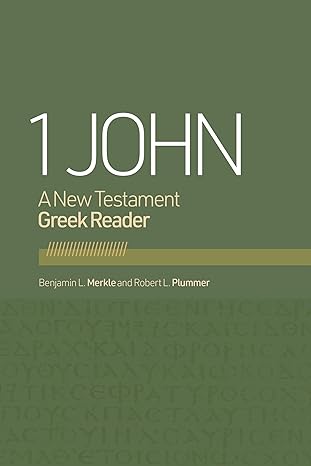A Book Review from Books At a Glance
by Nick Harsh
When this book arrived in the mail, I was eager to begin reading. At that time, the church where I serve was beginning a sermon series through the book of 1 John, and I was excited to study 1 John in depth. Additionally, it had been several years since my last Greek class, so admittedly, my familiarity with the language is somewhat rusty. I had two major questions as I started reading the book. First, would it serve as a Bible study tool for 1 John, or is it mainly useful as a resource for Greek students? Second, I wanted to know how accessible the book is for someone like me who has forgotten some of the Greek I once knew.
While this book stretched my recollection of the Greek language, it was also very accessible (after a bit of review). The book’s structure and the pace at which each chapter progresses allow the reader to engage with the book of 1 John in a manageable way. Merkle and Plummer have done an excellent job creating a resource that will deepen the reader’s understanding of the Greek language as well as their knowledge of the Bible. The book’s structure is straightforward. It follows the major sections of 1 John and is divided into fourteen chapters. For instance, chapter one works through 1 John 1:1-4, the first section of the book. The subsequent chapters are divided into similar sections based on logical breaks in John’s Epistle. Additionally, each section focuses on a significant area of Greek grammar. Chapter one discusses “Koine Greek and Textual Criticism,” chapter two addresses “Nominative, Vocative, and Accusative Cases,” and the book continues in this manner.
The primary benefit of the book’s layout is that it allows readers to review essential aspects of the Greek language in a manner that deepens the reader’s hermeneutical understanding of the Bible. At times, the study of Greek can become disconnected from the very text it aims to illuminate. However, by framing the grammar, insights, and vocabulary within the context of 1 John, Merkle and Plummer have effectively mitigated this challenge.
Each chapter includes the following: twelve vocabulary words, a brief summary of NT Greek syntax, and verse-by-verse reading notes of 1 John.
-
- The vocabulary words chosen are those from the designated text that occur fewer than fifty times in the New Testament. The assumption is that words occurring more than fifty times have already been memorized. Merkle and Plummer state, “By the time the student finishes the textbook, he or she will have encountered every word appearing thirty times or more in the N.T. This means that a student could self-sufficiently use a NT Greek reader with the aid of footnotes” (p. 1). This feature of the book makes it a valuable tool not only for studying the book of 1 John but also for enhancing one’s proficiency in the Greek language
- In addition to the vocabulary words for memorization, each chapter includes a brief summary of New Testament syntax. These summaries follow the basic structure outlined in Going Deeper with New Testament Greek.
- Finally, Merkle and Plummer provide verse-by-verse reading notes that assist the reader in Bible study. These notes examine various aspects of syntax in the Greek language and offer specific insights into particular passages of Scripture found in 1 John. For example, chapter four analyzes 1 John 2:7-14 and focuses on the “Dative Case.” This means that the reading notes from that chapter concentrate on the dative case, with observations exploring how the dative case is used in the relevant verses (i.e., 1 John 2:7-14). This enhances the reader’s understanding of 1 John and reinforces the principles discussed in each chapter.
Merkle and Plummer clearly assembled this book with great thoughtfulness, making it a valuable resource for those looking to sharpen their understanding of the Greek language. Most of the focus in this review is on the book’s structure rather than the details of each chapter. The reason for this is evident: each chapter aims to take the reader deeper into the Biblical text. In other words, the goal is not to teach something new but to explore something old in greater depth. That said, Merkle and Plummer have developed an excellent tool for Greek students and pastors alike.
Before beginning this book, I had two questions: (1) Would it be accessible, and (2) would it enhance my understanding of 1 John? I am pleased to say that for the average Greek student, this book is accessible and provides a helpful refresher on several key principles of Greek grammar. Furthermore, by teaching these principles through the book of 1 John, readers will gain a deeper and fuller understanding of John’s Epistle (not merely an improved understanding of Greek). For these reasons, I am happy to recommend 1 John: A New Testament Greek Reader to any pastor or student eager to enhance their understanding of the Greek language.
Nick Harsh
